|
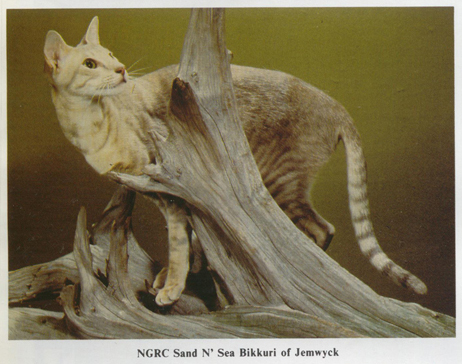
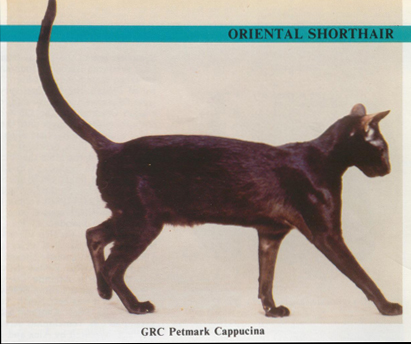
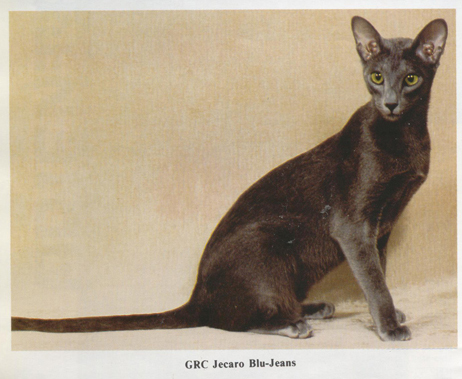
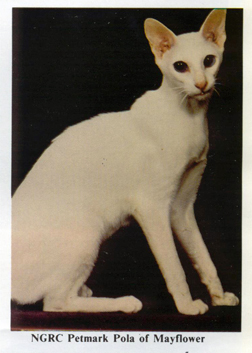
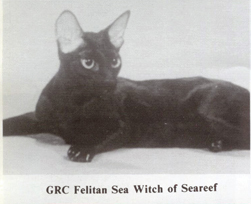
|
BIKKURI
Jayne E. Murray
The year was 1977, the date was January 5th, and on Cape Cod at
the Sand n’ Sea Cattery a tiny lavender spotted tabby Oriental female,
who was destined to become GRC NW Sand n’ Sea Bikkuri of Jemwyck, was
born. It was a red letter day, although no one knew it at the time.
I remember, as though it was yesterday, watching a very pretty little
kitten walking down the hall of Alison Hedberg’s house. A long legged
little spotted creature, her long skinny tail straight up and waving back
and forth as she walked. She was so special, loaded with confidence and
elegance even at that age. She really was intriguing with that lavender
spotted coat that covered a trim little body, and I asked Alison if she
had any plans for her. Alison said no, and I promptly said I’d like to
have her. Alison said “she’s yours,” and that was the beginning of a
very exciting show season and a long love affair with Bikkuri.
Her show career began to flourish at her very first show when she finaled
in every ring, with several Best Kitten awards. At
Boston
in September of 1977, as an open, she finaled in several rings and made
her championship. The next month at the
Garden
State
show, she was best champion in three rings and second best champion in the
4th ring. She missed becoming a grand at that show by 5 points,
but took care of that two weeks later at the Nutmeg Cat Fanciers show in
New Haven
,
Conn.
She granded with 250 points. She was really living up to her name, which
is Japanese for a pleasant surprise. Bikkuri and I went to one show a
month and each show she continued to final. The biggest thrill came in
February 1978 at the Empire cat show in
New York City
. The spectators at that show were, as usual, wall to wall and at times
the crowd around Bikkuri’s cage was so deep that I couldn’t see her
cage. The spectators dubbed her the “Pink Panther” and followed her
around when she went up to the ring, and cheered when she was best
Oriental in every ring. Sunday was a repeat of Saturday and Bikkuri was in
his glory. Final time came and Bikkuri was awarded Best Cat in 3 rings and
8th Best Cat in the 4th. It was a very exciting and
wonderful experience. It would have been perfect if Alison had decided to
come to that show and witnessed her success.
Bikkuri was a very special cat, and I believe she knew it. She loved the
shows, from her first in 1977 to her last show in 1986 when she was
invited to be a guest of honor at the first annual show of the Oriental
Shorthairs of America (OSA). She hadn’t been to a show since 1978, but
she loved it, enjoyed seeing old friends and meeting new ones that came to
see her, and to take her picture. I was truly surprised at the number of
people who stopped by.
The 1977-78 show season was truly a memorable one for Oriental Shorthairs.
Bikkuri was Best Oriental and Fifth Best Cat in the National Awards. For
the first time in CFA history a breed newly recognized for championship
had a cat representing that breed win a place in the top twenty highest
scoring cats in the country, the first year the breed was eligible for
championship competition.
1979 saw another Oriental in the top 20, GRC Patapaw Firefly bred and
owned by Marilyn T. Buchanan was 17th Best Cat. She was a
lovely blue-cream cat and 2nd best cat in the
Midwest
region. That same year had another winning Patapaw Oriental, GRC Patapaw
Moonbeam; an ebony was 10th best cat in the
Midwest
. The North Atlantic region had two Orientals in its top ten with GRC
Petmark Cappucina,* a chestnut bred and owned by the Marksteins as 4th
best cat, and GRC Jecaro Blu-Jeans* bred and owned by Bill, Wanda and Jean
Kunzelman was 8th best cat.
1980 was the year of the Perelandra cats. The best OSH and MW 8th
best cat was GRC Perelandra’s Mnemosyne (bred and owned by Valerie and
John Belevage), the second best was GRC Perelandra’s Esspresso of Eclat
(owned by Diane Vlasak and Melba Katz), and Perelandra’s Tachyon was 4th
best kitten. 1981 had a blue-eyed white, GRC Crystaljade Bianca of Petmark
(bred by Randy and Deborah Murphy and owned by Yvonne McMurray), as best
OSH
. The second best was an ebony, Aviva's Kuro Neko (bred and owned by Jeff
and Alicia Kaiser). This was the first time that a white was best OSH but
certainly not the last as 1982 saw GRC Petmark Pola of Mayflower* (Bred by
Peter and Vicky Markstein and owned by Muriel Slodden) as Best OSH. In
1983 and Oriental was again in the top twenty with GRC Ogimi Dorien Grey,
a lavender tabby bred by Robert and Barbara Gordon, owned by J. Gordon, B.
Gordon and B. Baylor.
In 1978 there were six grand champion Oriental Shorthairs from three
catteries, Patapaw, Sand n’ Sea, and Tawnee. Most of these cats were
bred from imported Orientals and American Siamese. In 1983 there were 16
grands from 12 catteries, and in 1984 there were 31 grands from 21
catteries. 1984 was a big year, not in national winners – no Orientals
made the top twenty – but in the fruition of Orientals synthesized in
the
U.S.A.
, in numbers diversity, and the beginnings of Oriental dynasties to come.
The regional award winners of 1984 are cats that seem like a who’s who
of important cats behind many of today’s winners. In the South West
region the best OSH was GRC Derry Downs Summer Night (and ebony bred by
Cherylee DeYoung), the Southern region has as best OSH GRC Printer’s
Balbriggan (an ebony tabby bred by Ann and Bob Sumrall, owned by Pat and
Dave Glass) and as 9th best kitten Felitan’s Chelsea of
Kaybill (bred by Dick and Barbara Levitan and owned by William and
Kathleen Wentling.) The best Midwest OSH and 19th best cat was
GRC RuRu Red Spreeder (bred and owned by Barbara Rudolf) and GLR 10th
best cat and best
OSH
was GRC Illawong My Familiar of Dajens (bred by Mrs. S. Rawlinson, and
owned by Irma Jenei). The NWR had as 11th best cat San-Toi’s
Tootsie (a chestnut bred and owned by D. Johnson and C. Roberts) and
another oriental as 14th best cat Shammar’s Spider (and ebony
bred and owned by S. Martin and L. Campbell), the NAR had as best OSH GRC
Felitan Silvanus (a silver tabby bred and owned by Barbara and Dick
Levitan) and as 8th best kitten Felitan Sea Witch of Seareef*
(owned by Al and Jan Garraputa.)
Not all American Oriental Shorthairs are descended from imported
Orientals. Some Oriental breeders started from scratch, using American
Shorthairs and Siamese to found their lines. It was exciting to
‘create’ the breed de novo and by using American Shorthairs, early
Oriental breeders had a whole new color palette with which to work.
Barbara Harr (Harr cattery) had been primarily a Colorpoint breeder but
had become a little bored with only a few colors, a common pattern for
Oriental breeders. When the possibility arose she obtained a first
generation Oriental, a cat with an American Shorthair parent, and started
breeding back to Siamese for type. In the next generation she had cats
that were unmistakably Orientals.
* denoted cat pictured |


